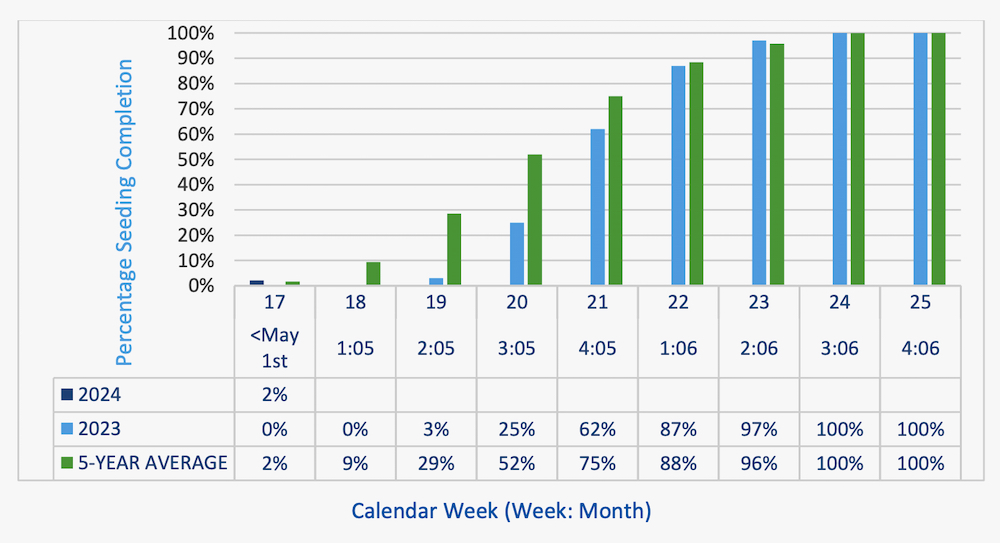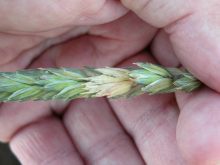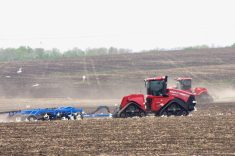Seeding progress across the province has just begun with approximately 2 per cent of the acres being seeded. Producers have begun seeding spring wheat, barley, oats, and corn. The Central region is most advanced with approximately 10 per cent of each of the major cereals planted. Corn planting is approximately 1 per cent complete.
Cereals
Winter wheat and fall rye survival is decent, with most producers observing winter cereal survival to be 80-90 per cent. Most producers have completed fertilizer applications in their winter cereals.
Read Also

ATP Nutrition wins agronomy innovation award at Ag in Motion 2025
Manitoba’s ATP Nutrition wins Ag in Motion 2025 Innovation in Agriculture Award for agronomy for its Synergro G3 biostimulant.
Spring wheat and barley is sitting at 4 per cent complete across the province with the central region being the most advanced at 10 per cent complete.
Oilseeds
No oilseed crops planted to date.
Pulses and Soybeans
Field pea planting is at 4 per cent complete across the province. The central region is the most advanced at 10 per cent complete and the southwest region is at 3 per cent complete.
Statistics Canada projected spring seeding report for Manitoba has soybean acres listed at 1.48 million acres.
Forages & Livestock
Forages
Pastures and hayfields are starting to green up and some alfalfa is coming out of dormancy. However, regrowth is being hampered by cooler and dry conditions. Some fertilization of hay stands is underway.
Hay and pasture stands are rated as being in fair condition with topsoil moisture being mostly adequate.
There have been some reports of winterkill concerns on forage establishment. The number of affected acres is low but may increase as inspections occur.
Livestock
Most cattle remain in their winter-feeding areas, though some operations have opened smaller paddocks adjacent to corrals to allow animals more space and to get them out of the mud. Hay supplies are adequate with some producers expecting to have carry-over for next year.
Water supplies are adequate. Dugouts have been recharged due to snowmelt and spring run-off; however, water levels in some areas are still considered low.
Regional Comments
Southwest
Rain during the week in different parts of the region gave a good moisture boost to soils. Southern parts received the highest amounts, with Minto and Wawanesa area receiving 35 mm and other areas receiving 10-25 mm. Northern areas received a few showers as well. Optimum moisture conditions are reported in most of the region. Temperatures are getting back to normal to above normal during the day, but nighttime temperatures were below zero last week. Windy conditions are helping to dry down the soils quickly.
Some producers have started seeding in southern areas of the region. Cereals and peas are the two major crops producers are seeding first. Total seeding progress is less than 3 per cent at this stage. Producers have been preparing their soils and trying to calibrate their equipment for seeding operations.
Winter wheat and fall rye are coming along nicely. Producers are assessing winterkill in their crops and planning for fertilizer application.
Northwest
A week of warmer, drying weather led to an improvement in field conditions. Some field work has started near the end of last week. Harrowing and fertilizing started over the weekend, however there are still fields with standing water in low areas. A very few select fields have been seeded. Field preparation and fertilizing will continue. Soil moisture at this point is adequate for most of the region.
Fall rye and winter wheat conditions in the region are varied. There has been some winterkill on fall rye in the Swan River area. In areas with adequate snowfall, fall rye and winter cereals have fared well so far.
Seeding of field peas and spring wheat in Dauphin/Swan River area over the weekend. Less than 1% for each crop.
Central
Last week’s dry and windy start gave way to cooler temperatures and light rainfall events over the weekend. The rainfall provided a moisture boost to soils, with the western part of the region experiencing the most precipitation. Rainfall was the highest in Baldur (29.3 mm), and lowest in Altona (9.9 mm). There was much activity in fields over the past two weeks. Recent rainfalls have halted field operations for the time being, with some fields having standing water in low lying areas. This rainfall has been welcomed by most producers and will provide necessary moisture for cash crop establishment and pasture growth.
Many producers have already seeded cereals and peas, with approximately 10 per cent of oats, spring wheat, barley, and pea already in the ground. The proportion of each crop seeded varies greatly at the local level across the region, with percentage of crop in the ground lower in the northwest and higher in the southeast. A very small number of producers have begun to plant corn (<1%), but the vast majority will not begin until favorable conditions return.
Winter wheat and fall rye survival is decent, with most producers observing winter cereal survival to be 80 -90 per cent. Most producers have completed fertilizer applications in their winter cereals.
Eastern
Rainfall accumulations across the Eastern region last week ranged from 8-25 mm. Daytime temperatures started at normal to above normal levels but dropped to below normal and cool for most of the week as rainy conditions moved through. Winds were strong most days as well.
No field operations are currently occurring. Some fields have standing water in low areas. However, if weather conditions continue to cooperate, fields will dry quickly and allow producers access.
Winter cereal fertilizer applications are about 80 per cent complete and will resume once weather allows. Winter cereal survival is still being evaluated and the absence of consistent warm temperatures has complicated stand evaluation. While some stands will be fully or partially terminated it appears most fields will continue with their condition ranging from fair to good. About 1 per cent of spring wheat and grain corn acres were planted across the region last week before the rain moved in. Many producers have not started seeding yet. Very little tillage or other field preparation occurred because of soil conditions.
Interlake
The region received some much needed moisture last week. The south Interlake received about 25 mm of rain last Friday in the St. Andrews area and 20 mm in the Arborg area, delaying the start of field operations. Soil moisture varies from very wet to adequate depending on the area. Temperatures are normal to above normal during the day with average temperature ranging from 3 to 11 C. The Gimli area had night temperatures below 2 C.
General seeding has not begun in the Interlake region due to moist soil conditions and intermittent rainfall the past week. There was some cereal seeding in Meadows and the southwest corner in the Interlake region. However, most producers are waiting to get good drying conditions to start seeding. Some field work including fertilization of fall rye is ongoing in the Interlake region. Also, some broadcasting of grass seed in the Teulon area.



















